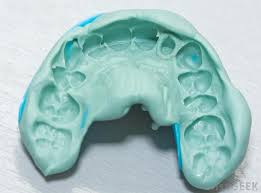 3D printing and scanning technologies are digitizing dentistry. Instead of the old-fashioned way of taking impressions for things like braces and retainers, which would involve subjecting a patient to biting down on a mouthful of foul-tasting goo, more and more dentists and orthodontists are scanning their patients’ dental anatomy instead. Those scans are then used to 3D print dental models. This is not only easier on the patient, but it’s faster. While many dental offices are sending their digital files to laboratories to have them 3D printed, there is also a growing number of offices that have their own 3D printers, meaning that they can instantly print out the models while patients wait.
3D printing and scanning technologies are digitizing dentistry. Instead of the old-fashioned way of taking impressions for things like braces and retainers, which would involve subjecting a patient to biting down on a mouthful of foul-tasting goo, more and more dentists and orthodontists are scanning their patients’ dental anatomy instead. Those scans are then used to 3D print dental models. This is not only easier on the patient, but it’s faster. While many dental offices are sending their digital files to laboratories to have them 3D printed, there is also a growing number of offices that have their own 3D printers, meaning that they can instantly print out the models while patients wait.
How accurate are these models, though? That’s the question that a group of University of Oklahoma researchers asks in a paper entitled “Accuracy of 3-dimensional printed dental models reconstructed from digital intraoral impressions.“
“A rapidly advancing digital technology in orthodontics is 3-dimensional (3D) modeling and printing, prompting a transition from a more traditional clinical workflow toward an almost exclusively digital format,” the researchers state. “There is limited literature on the accuracy of the 3D printed dental models. The aim of this study was to assess the accuracy of 2 types of 3D printing techniques.”
Those two types of 3D printing techniques were digital light processing (DLP) and PolyJet. For the study, the researchers took both digital and traditional alginate impressions from 30 patients. The digital impressions were used to 3D print models using both DLP and PolyJet printing techniques, and the alginate impressions were poured in stone. Measurements for the three model types (digital, DLP and Polyjet) were compared with the stone models.
Tooth measurements (first molar to first molar) included mesiodistal (crown width) and incisal/occlusal-gingival (crown height). Arch measurements included arch depth and intercanine and intermolar widths. Intraobserver reliability of the repeated measurement error was assessed using intraclass correlation coefficients.
“The intraclass correlation coefficients were high for all recorded measurements, indicating that all measurements on all model types were highly reproducible,” the researchers state. “There were high degrees of agreement between all sets of models and all measurements, with the exception of the crown height measurements between the stone and DLP models, where the mean difference was statistically significant.”
 The researchers conclude, therefore, that digital impressions and 3D printed models are perfectly viable for clinical applications. This isn’t a surprising conclusion; the accuracy and precision of scanning technology and 3D printing has been heralded by many. This study, however, gives scientific backing to the many claims that are out there. This should encourage many dental professionals that may be hesitant about turning to 3D printing to give the technology a chance; their patients will likely greatly appreciate it, and the results will be just as effective – if not more so – than the less-comfortable traditional techniques.
The researchers conclude, therefore, that digital impressions and 3D printed models are perfectly viable for clinical applications. This isn’t a surprising conclusion; the accuracy and precision of scanning technology and 3D printing has been heralded by many. This study, however, gives scientific backing to the many claims that are out there. This should encourage many dental professionals that may be hesitant about turning to 3D printing to give the technology a chance; their patients will likely greatly appreciate it, and the results will be just as effective – if not more so – than the less-comfortable traditional techniques.
Authors of the paper include Gregory B. Brown, G. Fräns Currier, Onur Kadioglu and J. Peter Kierl.
Discuss this and other 3D printing topics at 3DPrintBoard.com or share your thoughts below.


34 Replies to “How Accurate are 3D Printed Dental Models?”
Comments are closed.